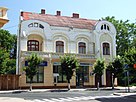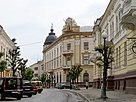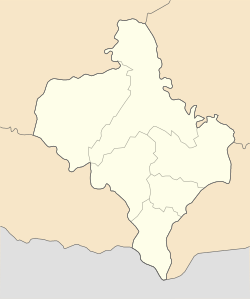Kolomyia
Kolomyia
Коломия | |
|---|---|
|
Brandmark | |
| Coordinates: 48°31′50″N 25°02′25″E / 48.53056°N 25.04028°E | |
| Country | |
| Oblast | Ivano-Frankivsk Oblast |
| Raion | Kolomyia Raion |
| Hromada | Kolomyia urban hromada |
| Area | |
| • Total | 41 km2 (16 sq mi) |
| Population (2022) | |
| • Total | 60,821 |
| • Density | 1,494/km2 (3,870/sq mi) |
| Website | www.ko.if.ua City's administrative statistics at Verkhovna Rada web-site[permanent dead link] |
Kolomyia, formerly known as Kolomea (
The city is a notable railroad hub, as well as an industrial centre (
History
It has been suggested that this section be History of Kolomyia. (Discuss ) (March 2022) |
The settlement of Kolomyia was first mentioned by the
Under Poland (1340–1498)
In 1340 it was annexed to Poland by King
Prior to 1353 there were two
Development



In 1405 the town's
Since the castle gradually fell into disarray, in 1448 King
The area was relatively peaceful for the next century. However, the vacuum after the decline of the
In 1490, due to increased oppression of Ukrainians at the hands of the Polish, a series of successful rebellions was led by modern Ukrainian hero Petro Mukha, joined by other Ukrainians, such as Cossacks and Hutsuls, in addition to Moldavians (
Decline
With the death of Stephen the Great of Moldavia, the neighbouring state started to experience both internal and external pressure from the Turks. As a consequence of border skirmishes, as well as natural disasters, the town was struck by fires in 1502, 1505, 1513, and 1520.
Under Moldavia (1498–1531)
After the
Polish – Ottoman wars
The following year, hetman Jan Tarnowski recaptured the town and defeated the Moldavians in the Battle of Obertyn. This victory secured the city's existence for the following years, but the Ottoman power grew and Poland's southern border remained insecure.
In 1589, the Turks crossed the border and seized Kolomyia almost immediately. All the burghers who had taken part in the defence were slaughtered, while the rest were forced to pay high indemnities.
The town was returned to Poland soon afterwards, but the city's growth lost its momentum.
In 1620, another Polono-Turkish war broke out. After the
After the war the area yet again returned to Poland. With the town in ruins, the
Khmelnytskyi Uprising

During the
In the 17th century the town`s outskirts saw another peasant rebellion led by
Partition of Poland – Jewish history
As a result of the first of Partitions of Poland (Treaty of St. Petersburg dated 5 July 1772), Kolomyia[9] was attributed to the Habsburg monarchy. More details about the history of Galicia can be read in the article Kingdom of Galicia and Lodomeria.
However, as it provided very little profit, Kolomyia was sold to the

Prosperity returned to the town in the mid-19th century, when it was linked to the world through the
20th century
In 1900 the Jewish population was 16,568, again nearly 50% of the town's population. The Jewish community had a Great Synagogue, and about 30 other synagogues. In 1910 Jews were prohibited from selling alcoholic beverages. In 1911 they were prohibited from salt and wine occupations.
After the outbreak of World War I, the town saw fierce battles between the forces of the Russian Empire and Austria-Hungary. Jews were abused for supposedly supporting the Austrians, and many Jewish homes were ransacked and destroyed.[citation needed] The Russian advance occupied the town in September 1914. In 1915 the Austrians retook the town.
As a result of the collapse of Austria-Hungary, both the town itself and the surrounding region became disputed between renascent Poland and the West Ukrainian People's Republic.
Second Polish Republic
However, during the
After the
In 1921 a music school was established in Kolomyia.[4]
After the outbreak of World War II with the Invasion of Poland of 1939, the town was thought of as one of the centres of Polish defence of the so-called Romanian Bridgehead.[citation needed]
Ukrainian SSR and German occupation in World War II

However, the Soviet invasion from the east made these plans obsolete, and the town was occupied by the Red Army.
As a result of the
On 14 November 1939, the Third Extraordinary Session of the
In 1940 part of the local population, Jews and Christians alike, were arrested by the NKVD,[citation needed] and sent to the Gulag system or to various Soviet prisons that contained Poles, Jews, Ukrainians, Hungarians, and many others.
In June 1941, the town was bombed by Nazi Germany airforce. This caused many Jews and young people to flee east. Briefly, the town was occupied by Hungary, a German ally. During their occupation, the Ukrainian townspeople launched a pogrom against Jews, beating, robbing, and humiliating them. Several hundred were forced to remove Lenin's statue from the town square. Ukrainians were preparing to shoot many when a deputy mayor stopped them. The Ukrainians prepared lists of Jews they wanted to see punished.
On August 1, the town became part of the German controlled Generalgouvernement and the anti Jewish measures increased. In October, the Germans and their Ukrainian auxiliaries arrested 3000 Jews according to the lists prepared by the Ukrainians. These Jews were taken by truck to the Szeparowce Forest where they were shot. The Great Synagogue in the town was burned. The next month, 2000 more were taken to the same forest by the Germans and their Ukrainian allies and shot and in December another 1200 suffered the same fate. More Aktions followed in January though March 1942 so that the Jewish population of the town, which had been 30,000 before June was now only 17,000. At this point, the Germans established a ghetto forcing Jews to move there within 24 hours. In April 5000 Jews were rounded up and sent to Belzec, where they were immediately murdered. In September 1942, more than 1000 Jews were selected to stay in the ghetto, being fit to work. Those in hiding were shot, and others sent to Belzec to be murdered. Jews from surrounding villages were brought to the ghetto and they too, with more Kolomyia Jews, were sent to Belzec. In February 1943, the last Jews, who had been kept behind as laborers were killed by clubbing and shooting. Overall, more than 70,000 Jews from Kolomyia and the area were killed in Kolomyja and the Szeparowce Forest or sent to Belzec.
Only about 200 Jews were still alive when the Red Army liberated Kolomyia from the German invaders on 28 March 1944. Other Jews who had been deported or fled to the Soviet Union survived there. After liberation, many construction workers, teachers, doctors, engineers and other skilled professionals began to arrive to restore the ruined town. They arrived from the eastern part of Ukraine and other parts of the Soviet Union. But the Jewish community was not revived.
During the Cold War the town was the headquarters of the 44th Rocket Division of the Strategic Rocket Forces, which had previously been the 73rd Engineer Brigade RVGK at Kamyshin. The division was disbanded on 31 March 1990.[10]
Under independent Ukraine (1991–present)

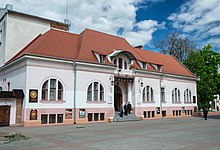

It is now a part of Ukraine, independent since 1991.
By the time of independence the vast majority of industrial enterprises of Kolomyia had closed or had been eliminated: Plant "
Most of these companies were widely known in the former Soviet Union and abroad, as they were highly advanced in terms of equipment, skilled workers, and engineering staff. These enterprises produced many products, with people working in several shifts, and providing the village with received significant tax revenues.
It is a
Since late 2015, Kolomyia has been the headquarters of the Ukrainian
Until 18 July 2020, Kolomyia was incorporated as a town of oblast significance and served as the administrative center of Kolomyia Raion though it did not belong to the raion. In July 2020, as part of the administrative reform of Ukraine, which reduced the number of raions of Ivano-Frankivsk Oblast to six, the town of Kolomyia was merged into Kolomyia Raion.[12][13]
Population
Language
Distribution of the population by native language according to the 2001 census:[14]
| Language | Number | Percentage |
|---|---|---|
| Ukrainian | 57 214 | 93.11% |
| Russian | 3 075 | 5.00% |
| Other or undecided | 1 159 | 1.89% |
| Total | 61 448 | 100.00% |
Economy
- Kolomyiasilmash
- Factory of the 17 September
- Factory of construction materials
- Factory combine of household services
Culture
- Museum of the History of Kolomyia
- National Museum of Hutsulshchyna and Pokuttya Folk Art
- Kolomyia is famous for its Pysanka Museum, that was built in 2000.
- The museum was opened on 23 September 2000, during the 10th International Hutsul festival. Director Yaroslava Tkachuk first came up with the idea of a museum in the shape of a pysanka, local artists Vasyl Andrushko and Myroslav :Yasinskyi brought the idea to life. The museum is not only shaped like an egg (14 m in height and 10 m in diameter), but parts of the exterior and interior of the dome are painted to resemble a pysanka.
- Church of the Annunciation of the Blessed Virgin Mary (1709)
- Academic Regional Ukrainian Drama Theater named after Iwan Osarkewytsch
Geography
Location
- Regional orientation
Climate
| Climate data for Kolomyia (1981–2010) | |||||||||||||
|---|---|---|---|---|---|---|---|---|---|---|---|---|---|
| Month | Jan | Feb | Mar | Apr | May | Jun | Jul | Aug | Sep | Oct | Nov | Dec | Year |
| Mean daily maximum °C (°F) | 0.5 (32.9) |
2.0 (35.6) |
7.1 (44.8) |
14.1 (57.4) |
20.0 (68.0) |
22.6 (72.7) |
24.7 (76.5) |
24.2 (75.6) |
19.2 (66.6) |
13.8 (56.8) |
6.3 (43.3) |
1.2 (34.2) |
13.0 (55.4) |
| Daily mean °C (°F) | −3.5 (25.7) |
−2.4 (27.7) |
2.0 (35.6) |
8.2 (46.8) |
13.7 (56.7) |
16.7 (62.1) |
18.6 (65.5) |
17.8 (64.0) |
13.1 (55.6) |
7.9 (46.2) |
2.1 (35.8) |
−2.5 (27.5) |
7.6 (45.7) |
| Mean daily minimum °C (°F) | −7.7 (18.1) |
−6.4 (20.5) |
−2.4 (27.7) |
2.8 (37.0) |
7.6 (45.7) |
11.0 (51.8) |
12.9 (55.2) |
12.0 (53.6) |
7.7 (45.9) |
3.2 (37.8) |
−1.5 (29.3) |
−6.0 (21.2) |
2.8 (37.0) |
| Average precipitation mm (inches) | 26.8 (1.06) |
28.8 (1.13) |
37.3 (1.47) |
54.2 (2.13) |
78.3 (3.08) |
109.2 (4.30) |
104.6 (4.12) |
86.2 (3.39) |
64.1 (2.52) |
42.7 (1.68) |
34.2 (1.35) |
34.2 (1.35) |
700.6 (27.58) |
| Average precipitation days (≥ 1.0 mm) | 6.8 | 7.2 | 7.8 | 8.9 | 10.7 | 12.1 | 11.0 | 10.6 | 8.5 | 7.6 | 7.5 | 8.2 | 106.9 |
| Average relative humidity (%)
|
82.2 | 80.9 | 77.6 | 72.3 | 73.0 | 76.0 | 75.8 | 78.0 | 80.3 | 81.6 | 84.9 | 85.4 | 79.0 |
| Source: World Meteorological Organization[15] | |||||||||||||
Twin towns – sister cities
Kolomyia is
 Drochia, Moldova
Drochia, Moldova Gniewino, Poland
Gniewino, Poland Kratovo, North Macedonia
Kratovo, North Macedonia Łapsze Niżne, Poland
Łapsze Niżne, Poland Łomża, Poland
Łomża, Poland Nysa, Poland
Nysa, Poland Rădăuți, Romania
Rădăuți, Romania Sighetu Marmației, Romania
Sighetu Marmației, Romania
Notable people
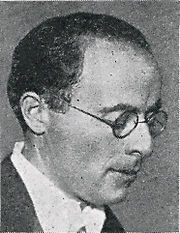

- Artem Chapeye (born 1981), Ukrainian writer
- Emanuel Feuermann (1902–1942), American-Jewish cellist
- Chaim Gross (1904–1991), American-Jewish sculptor and educator
- Roman Hryhorchuk (born 1965), Ukrainian football player and manager
- Myroslav Irchan (1897-1937), Ukrainian playwright
- Mieczyslaw Jagielski(1924–1997), Polish politician and economist
- Franciszek Karpinski(1741–1825), Polish 17th century poet
- Hillel Lichtenstein (1814-1891), Hungarian Jewish rabbi
- Karl Maramorosch (1915–2016), Austrian-born American virologist, entomologist, and plant pathologist
- Dov Noy (born 1920), Israeli folklorist, recipient of the Israel Prize in 2004
- Jakiw Palij (1923–2019), Trawniki concentration camp guard who was the last known Nazi to have lived in the United States
- Stanislaw Ruziewicz(1889–1941), Polish mathematician
- Józef Sandel (1894–1962), Polish-Jewish art historian and critic, art dealer, and collector
- Olesya Stefanko (born 1988), Ukrainian pageant, finished 1st runner-up at the 2011 Miss Universe pageant (Ukraine's highest placement to date)
- Andrzej Zalucki(born 1941), Polish diplomat
See also
- music, which originated in Kolomyia.
- Pokuttya
References
- ^ "Коломыйская городская громада" (in Russian). Портал об'єднаних громад України.
- ^ Чисельність наявного населення України на 1 січня 2022 [Number of Present Population of Ukraine, as of January 1, 2022] (PDF) (in Ukrainian and English). Kyiv: State Statistics Service of Ukraine. Archived (PDF) from the original on 4 July 2022.
- ^ a b c d e f Kolomyia at the Ukrainian Soviet Encyclopedia
- ^ a b c d e Verbylenko, H. Kolomyia (КОЛОМИЯ). Encyclopedia of History of Ukraine. 2007
- ^ town`s website
- ^ a b c d Kolomea history
- ^ Mukha's Rebellion
- ^ a b c d Semen Vysochan. Ukrainians in the World.
- ^ Atlas des peuples d'Europe centrale, André et Jean Sellier, 1991, p.88
- ^ 44th Missile Division
- ^ На Прикарпатті створять нову гірську штурмову бригаду - Народна армія [In the mountainous Carpathian region will create new assault brigade]. na.mil.gov.ua (in Ukrainian). Narodna armiya. 22 September 2015. Archived from the original on 31 January 2016. Retrieved 31 January 2016.
- ^ "Про утворення та ліквідацію районів. Постанова Верховної Ради України № 807-ІХ". Голос України (in Ukrainian). 18 July 2020. Retrieved 3 October 2020.
- ^ "Нові райони: карти + склад" (in Ukrainian). Міністерство розвитку громад та територій України.
- ^ "Рідні мови в об'єднаних територіальних громадах України" (in Ukrainian).
- ^ "World Meteorological Organization Climate Normals for 1981–2010". World Meteorological Organization. Archived from the original on 17 July 2021. Retrieved 17 July 2021.
- ^ "Коломия уклала партнерські угоди з Дрокією та Ришканами". kolrada.gov.ua (in Ukrainian). Kolomyia. Archived from the original on 2 August 2020. Retrieved 2 April 2020.
- ^ "Olena Iurkovska". Paralympic.org. International Paralympic Committee.
- ^ (in Ukrainian) Юрковська Олена Юріївна[permanent dead link], who-is-Who.ua
- ^ (in Ukrainian) Документ 287/2006, Verkhovna Rada (3 April 2006)
- ^ Viktor Yushchenko Decorates Paralympist Olena Yurkovska With Golden Star Order Archived 16 March 2017 at the Wayback Machine, Ukrinform (6 April 2006)
Further reading
- "Der Don Juan von Kolomea" (The Don Juan of Kolomyia), by Leopold von Sacher-Masoch
External links
- http://ww2.gov.if.ua/kolomiyskiy/ua (in Ukrainian)
- http://nad.at.ua/news/istorija_mista_kolomiji (in Ukrainian)
- http://leksika.com.ua/19200421/ure/kolomiya (in Ukrainian)
- ntktv.ua, the town`s television
- Історія Коломиї (in Ukrainian)
- kolomyya.org (in Ukrainian)
- pysanka.museum Pysanka Museum
- hutsul.museum Hutsul and Pokuttya National Folk Art Museum
- Heraldry and old pictures
- Picture gallery
- Kolomyia's Museum of Hutsul Folk Art
- New York-based Jewish organizations of exiles from Kolomyia Archived 24 December 2005 at the Wayback Machine
- JewishGen – The Kolomea Administrative District
- Memorial Book
- Photographs of Jewish sites in Kolomyia in the Jewish History in Galicia and Bukovina
- Kolomyya, Ukraine at JewishGen


